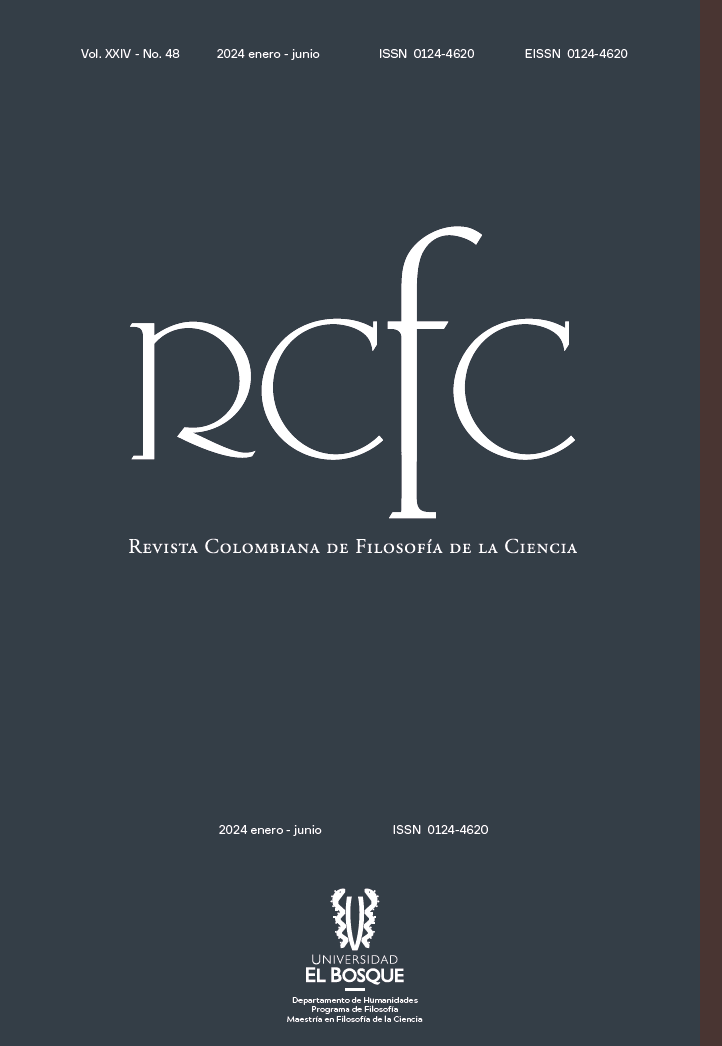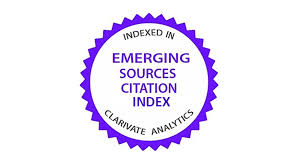Holismo local y cambio semántico en la teoría de Kuhn
Aristóteles, Newton y la inconmensurabilidad taxonómica
DOI:
https://doi.org/10.18270/rcfc.4409Palavras-chave:
Holismo, inconmensurabilidad, categoría taxonómica, cambio semántico, Kuhn, Aristóteles, NewtonResumo
El objetivo de este artículo es ahondar en la tesis de la inconmensurabilidad taxonómica defendida por Kuhn a partir de los años ochenta. Según el autor estadounidense, la inconmensurabilidad entre teorías, en esta versión más local y moderada, es el resultado del cambio semántico de algunos términos centrales, a los cuales denomina “categorías taxonómicas”. Según Kuhn, dichos términos están interdefinidos holísticamente, de manera que la modificación del significado de uno de ellos implica una redefinición del resto. Para extraer ejemplos de tal holismo local y de la reestructuración semántica que se produce tras una revolución científica, Kuhn acude a la física aristotélica y newtoniana. Sin embargo, aunque los considera ejemplos de gran relevancia y los utiliza como pruebas concluyentes de sus ideas, no los desarrolla en profundidad. Por lo tanto, este artículo se propone comprobar de manera más detallada si un análisis de tales teorías apoya la tesis de la inconmensurabilidad taxonómica.
Downloads
Referências
Achtner, Wolfgang, Kunz, Stefan y Walter, Thomas. Dimensions of Time. The Structures of the Time of Humans, of the World, and of God. Cambridge: Eerdmans, 2012.
Aristóteles. “Física”. Aristóteles II. Madrid: Gredos, 2011.
_____. Acerca del cielo. Madrid: Gredos, 1996.
Aubenque, Pierre. El problema del ser en Aristóteles. Madrid: Taurus, 1981.
Belkind, Ori. "Newton's conceptual argument for absolute space". International Studies in the Philosophy of Science 21.3 (2007): 271-293. <https://doi.org/10.1080/02698590701589551>
_____. “Leibniz and Newton on space”. Foundations of Science 18.3 (2013): 467-497. <https://doi.org/10.1007/s10699-011-9280-5>
_____. “Action, substance, and space in Newton’s metaphysics”. Iyyun: The Jerusalem Philosophical Quarterly 69 (2021): 31-56. <https://www.researchgate.net/publication/356459218_Action_Substance_and_Space_in_Newton's_Metaphysics>
Bird, Alexander. “Thomas Kuhn”. The Stanford Encyclopedia of Philosophy. Edward N. Zalta (ed.), 2022. <https://plato.stanford.edu/archives/spr2022/entries/thomas-kuhn/>
Cadavid-Ramírez, Lina M. y Arias-Vélez, Mateo. “La inconmensurabilidad kuhniana y las generalizaciones simbólicas: un análisis a partir de la comparación de dos paradigmas teóricos de la física”. Revista de la Academia Colombiana de Ciencias Exactas, Físicas y Naturales 45.175 (2021): 377-386. <https://doi.org/10.18257/raccefyn.1258>
Cala Vitery, Favio Ernesto. “La cuestión 31 de la óptica o el programa de las fuerzas en la filosofía mecánica”. Scientiæ Studia 4.2 (2006): 163-76. <https://doi.org/10.1590/S1678-31662006000200002>
Casini, Paolo. El universo máquina. Barcelona: Martínez Roca, 1971.
Chen, Chung-Hwan. The relation between the terms ‘energeia’ and ‘entelecheia’ in the philisophy of Aristotle. Classical Quaterly 8.1-2 (2009): 12-17. <https://doi.org/10.1017/S0009838800016360>
Cohen, I. Bernard. “Newton’s concepts of force and mass, with notes on the laws of motion”. The Cambridge Companion to Newton. I. B. Cohen y G. E. Smith (eds.). Cambridge University Press, 2004. 57-84. <https://doi.org/10.1017/CCOL0521651778.003>
Conill, Jesús. El tiempo en la filosofía de Aristóteles. Un estudio dedicado especialmente al análisis del Tratado del tiempo (Física IV, 10-14). Valencia: Facultad de Teología San Vicente Ferrer, 1981.
Descartes, René. El mundo o tratado de la luz. México D. F.: UNAM, 1986 [1664].
DiSalle, Robert. “Newton’s Philosophical Analysis of Space and Time”. The Cambridge Companion to Newton. Robert Iliffe y George E. Smith (eds.). Cambridge University Press, 2004. 33-56. <https://doi.org/10.1017/CCOL0521651778.002>
_____. “Absolute space and Newton’s theory of relativity”. Studies in History and Philosophy of Science Part B 71 (2020): 232-244. <https://doi.org/10.1016/j.shpsb.2020.04.003>
Einstein, Albert. “Prólogo”. Conceptos de espacio. Max Jammer (ed.). Ciudad de México: Grijalbo, 1970. 11-17.
Friedman, Michael. Foundations of Space-Time Theories. Princeton University Press, 1983.
_____. “Newton and Kant on absolute space: From theology to transcendental philosophy”. Interpreting Newton. Critical Essays. Andrew Janiak y Eric Schliesser (eds.). Cambridge University Press, 2012. 342-359. <https://doi.org/10.1017/CBO9780511994845.018>
Hacking, Ian. “Working in a new world: The taxonomic solution”. World Changes: Thomas Kuhn and the Nature of Science. Paul Horwich (ed.). Cambridge/Massachusetts/Londres: MIT Press, 1993. 275-310. <https://doi.org/10.2307/jj.11374771.13>
_____. “Ensayo preliminar”. La estructura de las revoluciones científicas. Thomas S. Kuhn. Madrid: Fondo de Cultura Económica, 2017.
Hall, A. Rupert. “Newton and the absolutes sources”. The Investigation of Difficult-Things Essays on Newton and the History of the Exact Sciences. Peter M. Harman y Alan E. Shapiro (eds.). Cambridge University Press, 1992. 261-285.
Henry, John. “Newton’s ‘De aere et aethere’ and the introduction of interparticulate forces into his physics”. Annals of Science 80.3 (2023): 232-267. <https://doi.org/10.1080/00033790.2023.2192721>
Hoyningen-Huene, George. Reconstructing Scientific Revolutions. The University of Chicago Press, 1993.
_____. “Kuhn’s development before and after structure”. Kuhn’s Structure of Scientific Revolutions: 50 Years On. William J. Devlin y Alisa Bokulich (eds.). Springer, 2015. 185-195
Jammer, Max. Conceptos de espacio. Ciudad de México: Grijalbo, 1970.
Janiak, Andrew. Newton as philosopher. Cambridge University Press, 2008. https://doi.org/10.1017/CBO9780511481512
_____ . “Substance and action in Descartes and Newton”. The Monist 93.4 (2010): 657-677. <https://doi.org/10.5840/monist201093437>
_____. “Metaphysics and natural philosophy in Descartes and Newton”. Foundations of Science 18 (2013): 403-417. <https://doi.org/10.1007/s10699-011-9277-0>
Jarnicki, Paweł y Greif, Hajo. “The ‘Aristotle experience’ revisited: Thomas Kuhn meets Ludwik Fleck on the road to structure”. Archiv für Geschichte der Philosophie (2022). <https://doi.org/10.1515/agph-2020-0160>
Koyré, Alexander. Newtonian Studies. Londres: Chapman and Hall, 1965.
_____. Estudios galileanos. Madrid: Siglo XXI Editores, 1980.
Kuhn, Thomas S. The Structure of Scientific Revolutions. University of Chicago Press, 1970.
_____. La tensión esencial. Estudios selectos sobre la tradición y el cambio en el ámbito de la ciencia. Madrid: Fondo de Cultura Económica, 1993a.
_____. “Afterwords”. World Changes Thomas Kuhn and the Nature of Science. Ed. Paul Horwich. Cambridge/Massachusetts/Londres: MIT Press, 1993b. 311-341.
_____. La revolución copernicana. La astronomía planetaria en el desarrollo del pensamiento. Barcelona: Ariel, 1996.
_____ “Conmensurabilidad, comparabilidad y comunicabilidad”. El camino desde la estructura. James Conant y John Haugeland (comps.). Barcelona: Paidós, 2002a [1982]. 47-75.
_____. “¿Qué son las revoluciones científicas?”. El camino desde la estructura. James Conant y John Haugeland (comps.). Barcelona: Paidós, 2002b [1987]. 23-45.
_____. “Mundos posibles en la historia de la ciencia”. El camino desde la estructura. James Conant y John Haugeland (comps.). Barcelona: Paidós, 2002c [1989]. 76-112.
_____. “El camino desde La estructura”. El camino desde la estructura. James Conant y John Haugeland (comps.). Barcelona: Paidós, 2002d. 113-129.
_____. “Una conversación con Thomas Kuhn”. El camino desde la estructura. James Conant y John Haugeland (comps.). Barcelona: Paidós, 2002e. 299-374.
Kuukkanen, Jouni-Matti. Meaning Changes: A Study of Thomas Kuhn's Philosophy. AkademikerVerlag, 2012.
Mayoral de Lucas, Juan Vicente. “Mundos fenoménicos y léxicos científicos: el relativismo lingüístico de Thomas Kuhn”. Revista de Filosofía 42.1 (2017): 117-134. <https://doi.org/10.5209/RESF.55452>
McDonough, Jeffrey K. “A ‘Rosa multiflora’ by any other name: Taxonomic incommensurability and scientific kinds”. Synthese 136 (2003): 337-358. <https://doi.org/10.1023/A:1025116814353>
McGuire, James E. y Tanmy, Martin. Certain Philosophical Questions: Newton’s Trinity Notebook. Cambridge University Press, 1983.
Musso, Paolo. “Why Newton’s absolute space-time is not so sbsolute and Einstein’s relative space-time is not so relative”. Epistemologia 37.1 (2014): 152-157. <https://doi.org/10.3280/EPIS2014-001010>
Newton, Isaac. Opticks. Nueva York: Dover Publications, 1952 [1730].
_____ . Mathematical Principles of Natural Philosophy. Vols. I y II. Berkeley: University of California Press, 1974 [1687].
_____ . “De gravitatione”. Newton. Philosophical Writings. Andrew Janiak (ed.). Cambridge University Press, 2004. 12-39.
Nietzsche, Friedrich. Sobre verdad y mentira en sentido extramoral. Madrid: Tecnos, 1996 [1873].
Qu, Li. “Newton, Einstein and Barth on Time and Eternity”. Scottish Journal of Theology 67 (2014): 436-449. <https://doi.org/10.1017/S0036930614000209>
Reisch, George A. “Aristotle in the Cold War: On the origins of Thomas Kuhn’s structure of scientific revolutions”. Kuhn’s ‘Structure of Scientific Revolutions’ at Fifty. Robert J. Richards y Lorraine Daston (eds.). University of Chicago Press, 2016. 12-30. <https://doi.org/10.7208/chicago/9780226317175.003.0001>
Rorty, Richard. La filosofía y el espejo de la naturaleza. Madrid: Cátedra, 1983.
Ross, William D. Aristóteles. Buenos Aires: Sudamericana, 1957.
Rossi, Paolo. El nacimiento de la ciencia moderna en Europa. Barcelona: Crítica, 1998.
Rynasiewicz, Robert. “Newton’s views on space, time, and motion”. The Stanford Encyclopedia of Philosophy. Edward Zalta (ed.), 2014. <https://plato.stanford.edu/archives/sum2014/entries/newton-stm/>
Schliesser, Eric S. “Newton and Spinoza: On motion and matter (and God, of course)”. The Southern Journal of Philosophy 50.3 (2012): 436-458. <https://doi.org/10.1111/j.2041-6962.2012.00132.x>
_____. “Newtonian emanation, Spinozism, measurement, and the Baconian origins of the laws of nature”. Foundations of Science 18 (2013): 449-466. <https://doi.org/10.1007/s10699-011-9279-y>
Sellés, Manuel y Solís, Carlos. Revolución científica. Madrid: Síntesis, 1994.
Stein, Howard. “Newton’s metaphysics”. Cambridge Companion to Isaac Newton. I. Bernard Cohen and George E. Smith (eds.). Cambridge University Press, 2002.
Strong, Edward W. “Barrow and Newton”. Journal of the History of Philosophy 8.2 (1970): 155-172. <https://doi.org/10.1353/hph.2008.1726>
Voltaire. François-Marie. “Cartas filosóficas”. Voltaire I. Madrid: Gredos, 2010 [1734]. 1-161.
Van Dyck, Maarten y Verelst, Karin. “‘Whatever is neither everywhere nor anywhere does not exist’: The concepts of space and time in Newton and Leibniz”. Foundations of Science 18 (2013): 399-402. <https://doi.org/10.1007/s10699-011-9276-1>
Van Fraasen, Bas C. An Introduction to the Philosophy of Time and Space. Nueva York: Random House, 1970.
Wray, Brad. Kuhn’s Intelectual Path. Cambridge University Press, 2021.
Downloads
Publicado
Como Citar
Edição
Seção
Licença

Este trabalho está licenciado sob uma licença Creative Commons Attribution-NonCommercial-NoDerivatives 4.0 International License.

| Métricas do artigo | |
|---|---|
| Vistas abstratas | |
| Visualizações da cozinha | |
| Visualizações de PDF | |
| Visualizações em HTML | |
| Outras visualizações | |











